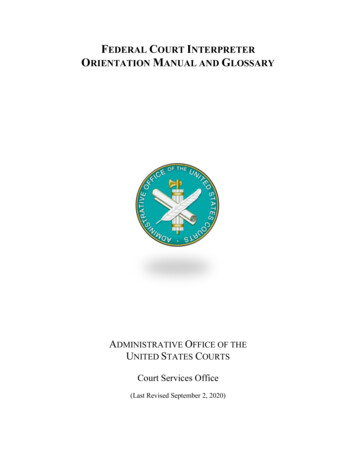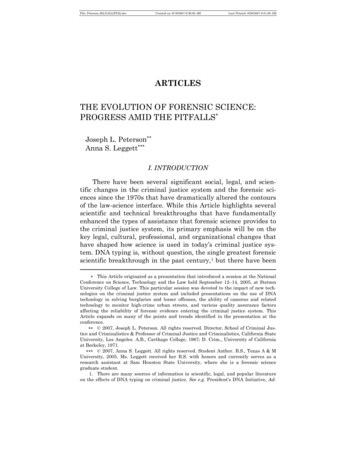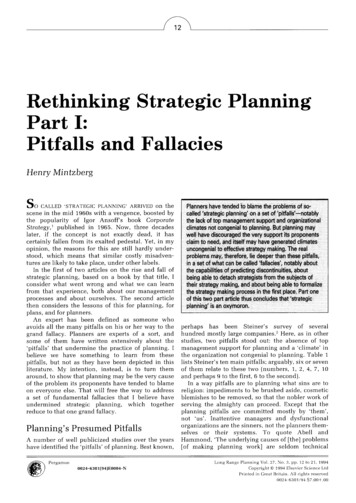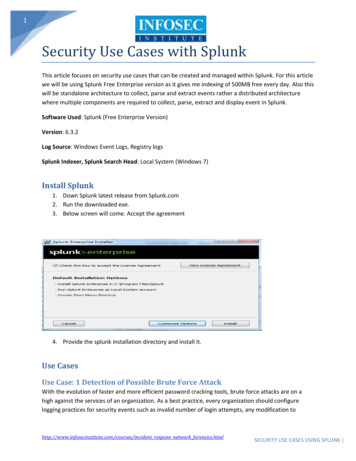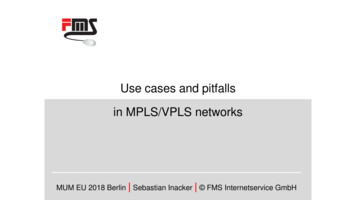
Transcription
Use cases and pitfallsin MPLS/VPLS networksMUM EU 2018 Berlin Sebastian Inacker FMS Internetservice GmbH
Contact Phone: 49 761 2926500 Email:sales@fmsweb.de Shop:https://www.mikrotik-shop.de MikroTik Mirror:http://www.mikrotik-software.de Twitter:https://twitter.com/fmsweb de Website:http://www.fmsweb.de Wiki:http://wiki.fmsweb.de ntations ce
About me Sebastian Inacker inacker@fmsweb.de FMS Internetservice GmbH,Germany MikroTik Trainer TR0011(May 2007) MTCNA, MTCRE, MTCTCE,MTCUME, MTCWE,MTCIPv6E, MTCINE
MikroTik trainings and workshops Own training center and on site(Austria, Germany, Greenland, Hungary,Luxembourg, Malta, Netherlands,Switzerland, Uganda) Inquiries: sales@fmsweb.de
Overview / big picture“Implementing and running a MPLS/VPLS network is easy.As long as it is running well.”Topics: Typical use cases of our (ISP) customers Typical pitfalls Surprising pitfalls Real world examples
Overview / big picture“Implementing and running a MPLS/VPLS network is easy.As long as it is running well.”Not main topics Step-by-step guide for each setup (focus on pitfalls) Reason for MPLS/VPLS (You should know, why)
Reasons for MPLS/VPLSOk, very short and incomplete Benefits of MPLS Routing more complex than MPLS Some future setups (L3 VPN, TE) require MPLSBenefits of VPLS vs. EoIP VPLS: No fragmentation (if done right) EoIP: Big overhead (42 bytes) & might cause fragmentation
Overview / big picturePitfalls: Incomplete (of course) Not limited to MPLS/VPLSNeeds for VPLS MPLS Routing (OSPF here) Physical infrastructure
Warning / heads-up / cautionThis presentation will include errors, mistakesand wrong configuration attempts to showresulting errors!Examples are simplified.Keep that in mind.
The beginning
Existing setup Existing OSPF network One PPPoE server EoIP (L2 tunnel) for client connections
Existing setupOSPFR4R2R3R6R5R1R7PPPoEInternetUplink router
Existing setupOSPFR4R2R3R6EoIP tunnelEoIP tunnelR5R1EoIP tunnelR7PPPoEInternetUplink router
Requirements for MPLSMPLS can be integrated without service disruptionRunning MPLS on top of OSPF: Enable LDP (Label Distribution Protocol) Set LSR ID (Label Switching Router's ID) Transport AddressIf left unset: Lowest IP of router will be used Create LDP interfaces
1st possible issue: LSR ID not uniqueR1R2Uplink: 192.168.2.2/30LAN: 10.0.0.1/24LSR ID 10.0.0.1NATR210.0.0.0/24R3R3Uplink: 192.168.3.2/30LAN: 10.0.0.1/24LSR ID 10.0.0.110.0.0.0/24
Unique IP for LDPUnique IP for LDP (LSR ID and Transport Address)Let‘s try 10.255.255. Router /32 on physical interface
Unique IP for OSPFUnique IP for OSPF (Router ID) – same issue as with LSR IDTake care: Setting of Router ID Restart of OSPF Loss of routing tableService affecting action!
LDP interfacesSet LDP interfaces Don‘t forget your backup path! Compare OSPF interfaces and LDP interfaces
Create VPLS tunnels
Check VPLS interfaceVPLS interface not running!
Check MPLSEmpty: MPLS Local Bindings MPLS Remote Bindings MPLS Forwarding Table
Check routingIP routes to 10.255.255.x are missing
Routing ok, VPLS ok
Lesson learnedMPLS is based on routing Broken/incomplete routing, broken/incomplete MPLS Broken MPLS, broken VPLSDebugging:Consider dependencies!
Working traceroute
Let‘s break things
Maintenance at backup linkOSPFR4R2R3R6VPLS tunnelVPLS tunnelR5R1VPLS tunnelR7PPPoEMaintenance at R4 (backup link). OSPF is going through R5.Customers at R3 complain. Customers at R6, R7 are fine.
Maintenance at backup linkOSPFR4R2R3R6VPLS tunnelVPLS tunnelR5R1VPLS tunnelR7PPPoE
Maintenance at backup linkR3: No link on ether410.255.255.3/32 on ether4
Maintenance at backup linkNo MPLS Forwarding / IP Routefor 10.255.255.3/32
Loopback bridgeloopback bridge is a good ideaLoopback bridge:Empty bridge with IP 10.255.255.x/32
Failure at main linkOSPFR4R2failureR3R6VPLS tunnelVPLS tunnelR5R1VPLS tunnelR7PPPoE
Failure at main linkExpected behaviour Routing through R4 PPPoE customers at R3, R6, R7 onlineObserved behaviourOSPF Routing through R4R4R2 PPPoE customers at R6, R7 offlinefailureR3R6VPLS tunnelVPLS tunnelR5R1VPLS tunnelR7PPPoE
Failure at main linkPing from R1 to R7 ok
Wrong LDP interfaces at R3 LDP: ether2 ether3 ether4 OSPF ether3 ether4 ether5
Examine setup
Monitor a PPPoE sessionBandwidth-test: PPPoE client to PPPoE server (download)R4R2R3R6VPLS tunnelVPLS tunnelR1R5VPLS tunnelPPPoE-TunnelR7PPPoE 203.0.113.1PPPoE-client
Monitor a PPPoE sessionBandwidth-test: PPPoE client to PPPoE server (download)MTU PPPoE Client: 1492 Bandwidth-test with 1492
Monitor a PPPoE sessionOn R1R2ether2R1ether3PPPoE 203.0.113.1 Interface to R2:1697 p/s Interface to PPPoE:846 p/s
FragmentationPacket fragmentation?Benefits of VPLS vs. EoIP VPLS: No fragmentation (if done right)
Packet sizesOriginal frame L3 Size 1500MTU 1500 Full Frame Size 1514ETH: 14IP (20) DATA (1480)ETH: 14PPPoE (8) DATA (1492)
Packet sizesInsertion of 1500 bytes (MTU) packet into VPLS tunnel:No fragmentationMTU 1500VPLS tunnelETH: 14MPLS (4) VPLS (4)ETH: 14IP (20) DATA (1480)ETH: 14PPPoE (8) DATA (1492)Original frameCW (4)ETH (14) PPPoE (8) DATA (1492)Full Frame MTUMPLS-MTU L2 MTU 1526 4 4 4 14 8 1492
Packet sizesVPLS packet is fragmented because:Resulting MPLS-MTU: 1526Interface MPLS MTU: 1508 (default)ETH: 14MPLS (4) VPLS (4)CW (4)MPLS-MTU L2 MTU 1526ETH (14) PPPoE (8) DATA (1492)
Increase interface MPLS MTUIf hardware capable: Increase interface MPLS MTU L2 MTU (see Maximum Transmission Unit on RouterBoards) RB433, RB450, RB493:ether1: 1526, ether2-last: 1522 RB433GL, RB450G, RB493G:all interfaces: 1520 Switches, media converters, ether1L2 MTU 1526ether2L2 MTU 1522RB450
MPLS MTU set to 1526MPLS Interface MTU: 1526 Corresponding packet counters PPPoE client Interface to backbone Interface to PPPoE server
Why 1508?1508 is enough for MPLS for packet forwarding (1 MPLS label)MTU 1500ETH: 14IP (20) DATA (1480)MTU 1500ETH (14) MPLS (4) IP (20) DATA (1480)MPLS-MTU L2 MTU 1504 4 1500
Why 1508?1508 is enough for MPLS for packet forwarding (1 MPLS label) Targeted LDP (2 MPLS labels)MTU 1500ETH: 14Default 1526 Too large (?)IP (20) DATA (1480)MTU 1500ETH (14) MPLS (4) IP (20) DATA (1480)MPLS-MTU L2 MTU 1504 4 1500MTU 1500ETH (14) MPLS (4) MPLS (4) IP (20) DATA (1480)MPLS-MTU L2 MTU 1508 4 4 1500
Network improvements
Current networkOSPFR4R2R3R6VPLS tunnelVPLS tunnelR5R1VPLS tunnelR7PPPoE
RedundancyRedundancy: Type / coverage depends on setup needs customer / network No claim for completeness ExamplesRedundancy can become complex. Complexity can result inissues.
Redundancy at main siteoptical fiberR1R2SwitchPPPoE #1PPPoE #2SwitchISP #1InternetISP #2Green frame: See presentation of Patrik Schaub(Access all FMS Internetservice presentations: click)
Redundancy at backbone Additional link / ip subnet between R1/R2 and R2/R3 2nd link is backup – same as on R3R4 OSPF interfaces:R2R3R6High(er) cost for backup link Don‘t forget to add LDP interfaceVPLS TunnelVPLS TunnelR1VPLS Tunnelmain siteR5R7
Redundancy at backboneR4R2R3R6VPLS TunnelVPLS TunnelR1VPLS Tunnelmain siteR5R7
Redundancy for R1 Clone R1: R1-Main (10.255.255.11) R1-Backup (10.255.255.12) Main link connected to R1-Main Backup link connected to R1-Backup VPLS go to R1-Main (10.255.255.1)R4R2R3R1-MainR6R5VPLS TunnelVPLS TunnelR1-BackupVPLS Tunnelmain siteR7
Redundancy for R1R4R2R3R1-MainR6R5VPLS TunnelR4VPLS TunnelR1-BackupR2R3VPLS TunnelR6R7VPLS TunnelVPLS TunnelR1VPLS Tunnelmain sitemain siteR5R7
Redundancy for R1Who is R1-Main / R1-Backup?R2Who is 10.255.255.1?R1-MainVPLS TunnelVPLS TunnelR1-BackupVPLS TunnelSwitchmain site No VRRP between Main / Backupon Interface to R2 (different L3networks)
Redundancy for R1Who is R1-Main / R1-Backup?R2Who is 10.255.255.1?SwitchR1-MainVPLS TunnelVPLS TunnelR1-BackupVPLS TunnelSwitch Same L2 for R1-Main, R1-Backupand R2 VRRP on R2 side Backup path: Decission by RSTPmain site
Redundancy for R1Who is R1-Main / R1-Backup?R2Who is 10.255.255.1?SwitchR1-MainVPLS TunnelVPLS TunnelR1-BackupVPLS TunnelSwitch Same L2 for R1-Main, R1-Backupand R2 VRRP on R2 side Backup path: Decission by RSTPmain site Failure on link to main site VRRP is fine Clients offline
Redundancy for R1Who is R1-Main / R1-Backup?R2Who is 10.255.255.1?R1-MainVPLS TunnelVPLS TunnelR1-BackupVPLS TunnelSwitch R1-Main and R1-Backup:Connected to main site switch VRRP on this side Management VLAN?main site
Redundancy for R1VRRP and MPLS on R1-Main IP 10.255.255.1/32 on VRRP interface LSR ID Transport address 10.255.255.1R2 10.255.255.11/32 on loopback, for OSPFR1-MainVRRP and MPLS on R1-Backup IP 10.255.255.1/32 on VRRP interfaceVPLS TunnelR1-BackupVPLS TunnelSwitch LSR ID Transport address 10.255.255.1main site 10.255.255.12/32 on loopback, for OSPFVPLS Tunnel
Let’s break test thingsFailure of R1-Main or failure of link to main siteExpected behaviourR2 10.255.255.1 on R1-Backup VPLS tunnels to R1-Backup up PPPoE clients reconnectingR1-MainVPLS TunnelVPLS TunnelR1-BackupVPLS TunnelSwitchObserved behavourmain site Everything fine (stop testing!)
Let’s break test thingsFailure of link R1-Main to R2Expected behaviourR2 10.255.255.1 on R1-Main R1-Main VPLS master R2: No route to 10.255.255.1 (OSPF) Clients offlineR1-MainVPLS TunnelVPLS TunnelR1-BackupVPLS TunnelSwitchmain site
Let’s break test thingsOSPF and LDP on crosslinkR2SwitchR1-MainExpected behaviourVPLS TunnelVPLS TunnelR1-BackupVPLS TunnelSwitch 10.255.255.1 on R1-Main R2: route to 10.255.255.1 VPLS ok & clients onlinemain siteObserved behaviour Clients offline
Let’s break test thingsTests from R2: Route via R1-Backup Ping to 10.255.255.1 ok Traceroute ok
Let’s break test thingsTests from R7: Ping to 10.255.255.1 ok Traceroute ?
Let’s break test thingsRouting between R1-Backup and R1-Main okMPLS/LDP broken on R1-Backup No forwarding TableRouting is not enough for VPLS!
Let’s break test thingsSimple reason: LSR ID and Transport Address 10.255.255.1 is used onR1-Backup and R1-Main(!) IP 10.255.255.1 is active only on R1-Main (VRRP master) Duplicate ID (and transport address): Good idea? (No.)
Let’s fix things(One possible) Solution: On VRRP Master:Set LSR ID and Transport Address to 10.255.255.1 On VRRP Backup:Set LSR ID and Transport Address to router unique address(available on loopback)Result: Working MPLS between routers(OSPF was useing unique address as Router ID.)
Let’s fix things/interface vrrpadd interface ether3 name vrrp-directed-to-pppoe \on-backup "/mpls ldp set transport-address 10.255.255.11 lsr-id 10.255.255.11" \on-master "/mpls ldp set transport-address 10.255.255.1 lsr-id 10.255.255.1" \preemption-mode no vrid 5R1-Main: 10.255.255.11R1-Backup: 10.255.255.12Note: Change of LSR IDService affecting
Traffic improvement
Use backup link Traffic from R7 to R1 through R4R4But: OSPF goes through R5R2R3R6 MPLS goes through R5 VPLS goes through R5R1-MainR5VPLS TunnelVPLS TunnelR1-BackupVPLS Tunnelmain siteR7
Traffic engineering (TE) tunnel Enable TE support on all involved interfacesFor example on R3:/mpls traffic-eng interfaceadd interface ether3add interface ether4add interface ether5(Compare with MPLS interfaces)
Traffic engineering (TE) tunnelUse TE tunnel.Here: No need for OSPF adjustments / single OSPF area No need for bandwith reservation / definition No need for Constrained Shortest Path First (CSPF)
Traffic engineering (TE) tunnel Configure primary and secondary tunnel path (R1, R7)/mpls traffic-eng tunnel-pathadd name tunnel-path-via-r4 use-cspf no hops 10.255.255.4:looseadd name dynamic-path use-cspf noR4R2R3R1-MainR6R5VPLS TunnelVPLS TunnelR1-BackupVPLS Tunnelmain siteR7
Traffic engineering (TE) tunnel Create TE Tunnel (R1, R7)/interface traffic-eng add \name traffic-eng-to-r7 \from-address 10.255.255.1 \to-address 10.255.255.7 \primary-path tunnel-path-via-r4 \secondary-paths dynamic-path
Result10 Mbit/s10 Mbit/sR420 Mbit/sR210 Mbit/sR320 Mbit/sR1-MainR610 Mbit/sVPLS Tunnel10 Mbit/sR5VPLS TunnelR1-BackupVPLS Tunnel10 Mbit/s to PPPoE client at R6 and R7R7
ResultR420 Mbit/sR220 Mbit/sR320 Mbit/sR1-MainR610 Mbit/sVPLS Tunnel20 Mbit/sR5VPLS TunnelR1-BackupVPLS Tunnel10 Mbit/s to PPPoE client at R6 and R7Failure of R4: Traffic through R5 (same for R5)R7
OSPF issue
OSPF setup (simplified)R12R01, R11 and R21 on same subnet Bridge on R01 Same horizon value R01 OSPF neigbors: R11, R2110.30.2.0/27R21R1110.30.1.0/2710.30.1.0/27R01
OSPF setup (simplified)R12Expected behaviour on R21 OSPF neighbour (only) R01 Route to 0/27Observed behaviour As expectedR01
OSPF setup (simplified)R12Reboot R01. No config change.10.30.2.0/27Expected behaviour on R21 OSPF neighbour (only) R01 Route to 10.30.2.0/27Observed behaviour 10.30.2.0/27 missingR21R1110.30.1.0/2710.30.1.0/27R01
Debug R21R12Debug R21 OSPF state to R01 full 10.30.2.0/27 01
Debug R01R12Debug R01 OSPF state to R11 & R21 full 10.30.2.0/27 01
OSPF Designated RouterR12OSPF with network type Broadcastwill elect Designated Router (DR).10.30.2.0/27R21R11Who is DR? R21 is DR!10.30.1.0/2710.30.1.0/27R01 R11 tries to update R21 - not allowed by bridge horizon or wireless default forward or bridge filter
PossibilitiesR12Possible solutions10.30.2.0/27 Force R01 to be DR Use network type ptmpR21R1110.30.1.0/2710.30.1.0/27R01
Thank you
FMS Internetservice GmbHPhone: 49 761 2926500Web: www.fmsweb.deShop: www.mikrotik-shop.deEmail: sales@fmsweb.deTwitter: https://twitter.com/fmsweb deMUM 2018 Berlin Sebastian Inacker FMS Internetservice GmbH
Reasons for MPLS/VPLS Ok, very short and incomplete Benefits of MPLS Routing more complex than MPLS Some future setups (L3 VPN, TE) require MPLS Benefits of VPLS vs. EoIP VPLS: No fragmentation (if done right) EoIP: Big overhead (42 bytes) & might cause fragmentation





